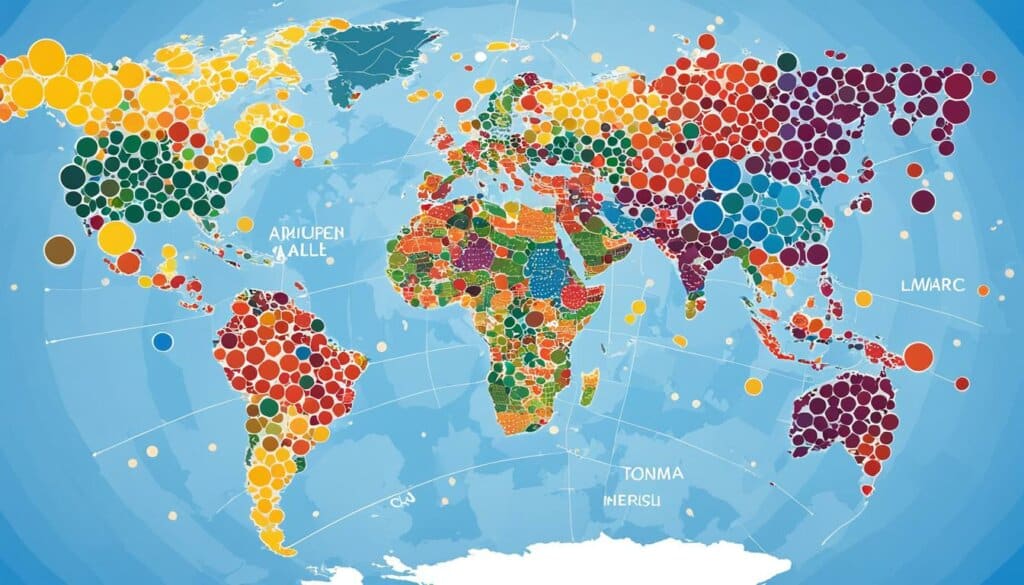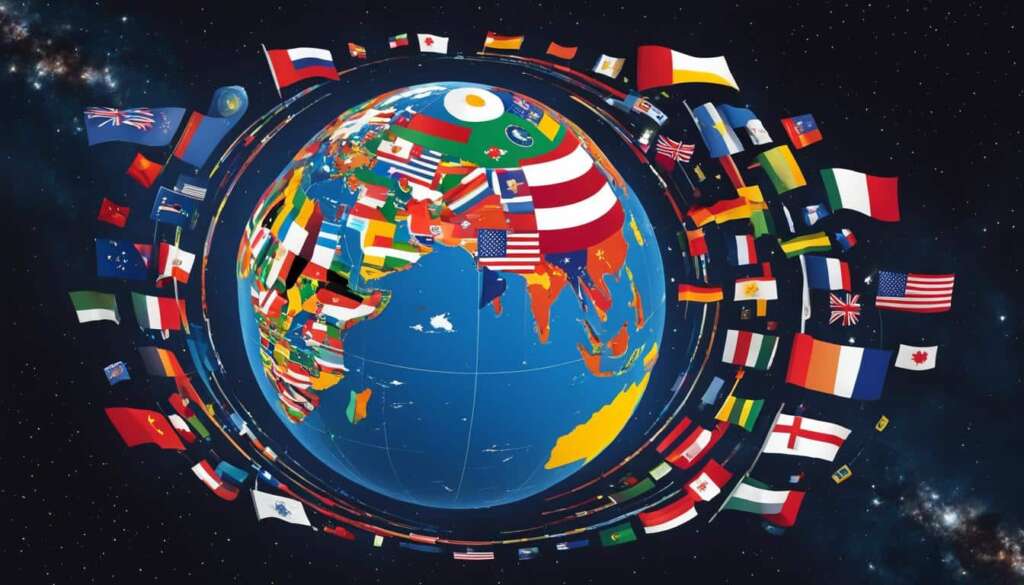Table of Contents
ChatGPT is a multilingual chatbot that supports over 50 languages, making it accessible to a global audience. With its advanced AI language models and natural language processing capabilities, ChatGPT offers seamless communication in various languages. Whether you’re conversing in English, Spanish, French, German, Chinese, Japanese, Arabic, or any other supported language, ChatGPT ensures a user-friendly experience.
As the world becomes more interconnected, the need for multilingual support is increasingly crucial. ChatGPT’s language compatibility allows businesses and individuals to connect with customers from different parts of the world, facilitating effective communication and breaking down language barriers.
With ChatGPT’s support for multiple languages, you can reach a wider audience, improve customer experience, save time and money, gain a competitive advantage, and enhance your brand image. Whether you’re a global organization or an individual seeking multilingual AI communication capabilities, ChatGPT’s multilingual support has numerous benefits to offer.
How Is ChatGPT Able To Communicate In Multiple Languages?
ChatGPT’s ability to communicate in multiple languages is made possible through a combination of advanced features and linguistic capabilities. By leveraging language recognition, natural language processing, and translation techniques, ChatGPT is able to provide multilingual communication for a diverse user base.
At its core, ChatGPT utilizes a series of models to power its language support. It has a dedicated layer that identifies the language used by the user, allowing the chatbot to adapt its response accordingly. This language recognition feature enables seamless communication across different linguistic backgrounds.
To understand the user’s input, ChatGPT employs natural language processing techniques. This layer analyzes and interprets the text, taking into account grammar, semantics, and context. By applying sophisticated linguistic features, ChatGPT can accurately comprehend the user’s message and provide relevant responses.
When it comes to responding in multiple languages, ChatGPT incorporates a translation layer. This component translates user queries or input into English or other supported languages. The generated response is then translated back into the user’s preferred language, ensuring effective multilingual communication.
ChatGPT’s language capabilities extend beyond mere translation. The chatbot also incorporates built-in language recognition tools that can identify dialects and accents. This feature enables ChatGPT to understand and respond to different linguistic variations, further enhancing its multilingual communication abilities.
In addition to language recognition and translation, ChatGPT offers advanced features that contribute to its ability to communicate in multiple languages. Voice recognition allows users to interact with the chatbot using spoken language, making it accessible to those who prefer voice-based communication. Image recognition capabilities enable ChatGPT to analyze and respond to image-based queries, expanding the possibilities of multilingual communication. Furthermore, ChatGPT incorporates emotion detection to provide responses that are sensitive to the user’s emotional state, adding a layer of personalized interaction.
Overall, ChatGPT’s language recognition, advanced linguistic features, multilingual communication, and language translation capabilities make it a powerful tool for engaging with users from diverse linguistic backgrounds. By facilitating seamless multilingual conversations, ChatGPT opens up new opportunities for global collaboration, understanding, and connectivity.
Overview Of ChatGPT Languages And Countries
ChatGPT is designed to support multiple languages to cater to a global audience. With its language support, ChatGPT aims to ensure effective communication for multilingual audiences worldwide. Currently, ChatGPT supports several languages, including:
- English
- Spanish
- French
- German
- Portuguese
- Italian
- Dutch
- Russian
- Arabic
- Chinese
Users can easily switch between languages by typing the name of their preferred language, and ChatGPT will automatically adjust for seamless communication. This language versatility allows ChatGPT to interpret and respond to queries accurately, providing a user-friendly experience for multilingual audiences.
As ChatGPT continues to interact with users and receive feedback, its language interpretation capabilities improve over time. This constant learning ensures that ChatGPT meets the evolving needs of its diverse user base, enabling effective communication in different languages.
Note: The image above represents the global reach of ChatGPT with its extensive language support.
What Languages Does ChatGPT Support?
ChatGPT is designed to support a wide range of languages, ensuring language compatibility and providing comprehensive language support for its users. It allows individuals and businesses around the world to communicate effectively in their preferred languages. The following table highlights the diverse languages supported by ChatGPT:
| Supported Languages |
|---|
| Albanian |
| Arabic |
| Armenian |
| Azerbaijani |
| Basque |
| Belarusian |
| Bengali |
| Bulgarian |
| Catalan |
| Chinese |
| Croatian |
| Czech |
| Danish |
| Dutch |
| English |
| Estonian |
| Filipino |
| Finnish |
| French |
| Galician |
| Georgian |
| German |
| Greek |
| Gujarati |
| Hebrew |
| Hindi |
| Hungarian |
| Icelandic |
| Indonesian |
| Italian |
| Japanese |
| Kannada |
| Kazakh |
| Korean |
| Latvian |
| Lithuanian |
| Macedonian |
| Malay |
| Malayalam |
| Marathi |
| Mongolian |
| Norwegian |
| Persian |
| Polish |
| Portuguese |
| Punjabi |
| Romanian |
| Russian |
| Serbian |
| Slovak |
| Slovenian |
| Spanish |
| Swahili |
| Swedish |
| Tamil |
| Telugu |
| Thai |
| Turkish |
| Ukrainian |
| Urdu |
| Uzbek |
| Vietnamese |
| Welsh |
| Xhosa |
| Yiddish |
| Zulu |

What Languages Is ChatGPT Written In?
ChatGPT is built using a combination of programming languages and components to create a powerful and efficient chatbot. The primary programming language used in developing ChatGPT is Python, which serves as the foundation for the core structure of the chatbot. This choice of language allows for flexibility, scalability, and ease of development.
The core structure of ChatGPT is enhanced by leveraging popular frameworks such as TensorFlow and PyTorch. These frameworks provide a robust and efficient platform for training and deploying the AI models that power ChatGPT’s language capabilities.
Furthermore, ChatGPT integrates various Natural Language Processing (NLP) frameworks and libraries to optimize its accuracy and capabilities. Some of these NLP frameworks include:
- spaCy: A powerful and flexible NLP library that offers advanced linguistic processing features.
- Gensim: An open-source library for topic modeling and document similarity analysis.
- NLTK (Natural Language Toolkit): A comprehensive toolkit for NLP tasks, including tokenization, stemming, tagging, and parsing.
- OpenNMT-py: A flexible and extensible toolkit for training and deploying Neural Machine Translation models.
These NLP frameworks and libraries enable ChatGPT to perform tasks such as language recognition, sentiment analysis, part-of-speech tagging, and more, enhancing its ability to understand and respond to user inputs accurately.
While ChatGPT is primarily written in Python, it also supports other major programming languages such as JavaScript, Java, Ruby, PHP, C++, and more. This versatility allows developers to create custom solutions and integrations using their preferred programming languages, further expanding ChatGPT’s applicability across different projects and organizations.
Popular Programming Languages Supported by ChatGPT:
| Programming Language | Description |
|---|---|
| Python | An interpreted, high-level programming language known for its simplicity and readability. |
| JavaScript | A versatile scripting language commonly used for web development. |
| Java | An object-oriented programming language known for its platform independence and wide range of applications. |
| Ruby | A dynamic, reflective, object-oriented programming language known for its concise syntax and ease of use. |
| PHP | A server-side scripting language commonly used for web development and can be embedded into HTML. |
| C++ | A powerful, general-purpose programming language known for its efficiency and extensive library support. |
Benefits Of Multilingual ChatGPT
Multilingual ChatGPT offers several benefits for businesses. It allows them to reach a wider audience by communicating with customers in their native languages, thus increasing revenue and expanding their global reach. By providing support in the customer’s preferred language, ChatGPT improves the customer experience, leading to increased satisfaction and loyalty. This multilingual chatbot can also save businesses time and money by automating customer service, allowing employees to focus on other important tasks. Furthermore, offering language support gives businesses a competitive advantage in the market, as it sets them apart from competitors and shows their commitment to meeting customer needs. By demonstrating a customer-centric approach, ChatGPT helps businesses improve their brand image, gaining the trust and loyalty of customers.
Key Benefits:
- Reach a wider audience by communicating in their native languages
- Improve customer experience and satisfaction
- Save time and money through automated customer service
- Gain a competitive advantage in the market
- Improve brand image and build trust with customers
Build A Custom Multilingual AI Chatbot
Building a custom AI chatbot with multilingual capabilities can be beneficial for businesses. It allows them to communicate with customers in their native languages, building trust and better customer relationships. A custom multilingual AI chatbot can also help businesses expand into new markets by reaching out to people who are more comfortable using languages other than English.
Platforms like Botpress simplify the process of building chatbots and offer a wide range of features to support multilingual communication. These features include:
- Language Support: Botpress provides comprehensive language support, allowing businesses to integrate multiple languages into their chatbot. This ensures that customers can interact in their preferred language, resulting in a more personalized and user-friendly experience.
- Multilingual Capabilities: With Botpress, businesses can easily configure their custom chatbot to understand and respond accurately in multiple languages. This opens up opportunities for global communication and extends the reach of businesses beyond English-speaking audiences.
- Conversation: Botpress enables seamless and natural conversation between users and chatbots. It leverages AI algorithms and natural language processing (NLP) techniques to understand the context and intent of user queries, regardless of the language used.
- Translation: Botpress offers built-in translation capabilities, allowing businesses to automatically translate user queries and responses between languages. This eliminates language barriers and ensures smooth communication between businesses and their customers.
- Text Completion: Botpress can assist chatbot developers by suggesting completed sentences or phrases, reducing the time and effort required to build multilingual chatbot responses. This feature improves efficiency and enables faster chatbot development.
By utilizing a custom multilingual AI chatbot, businesses can enhance their communication capabilities, improve customer satisfaction, and expand their global presence. With the right platform and features, creating a multilingual chatbot becomes a seamless process that empowers businesses to connect with customers in their preferred language.
Take a look at the table below to see a comparison of some popular platforms for building multilingual chatbots:
| Platform | Language Support | Multilingual Capabilities | Conversation | Translation | Text Completion |
|---|---|---|---|---|---|
| Botpress | ✔️ | ✔️ | ✔️ | ✔️ | ✔️ |
| Chatfuel | ✔️ | ❌ | ✔️ | ❌ | ❌ |
| Dialogflow | ✔️ | ✔️ | ✔️ | ✔️ | ❌ |
| IBM Watson | ✔️ | ✔️ | ✔️ | ✔️ | ❌ |
As shown in the table, Botpress excels in providing comprehensive multilingual capabilities, including language support, conversation, translation, and text completion.
With the right platform and a custom multilingual AI chatbot, businesses can unlock new opportunities, bridge language barriers, and deliver exceptional customer experiences.
Conclusion
ChatGPT’s multilingual support enables users to effortlessly communicate in multiple languages, revolutionizing AI-driven communication. With a diverse range of supported languages and advanced linguistic features, ChatGPT is an invaluable tool for businesses and individuals seeking seamless multilingual AI communication capabilities.
Whether you aim to reach a global audience, enhance customer experience, optimize efficiency, gain a competitive advantage, or strengthen your brand image, ChatGPT’s multilingual support offers a plethora of benefits that can significantly improve your communication strategies.
By leveraging ChatGPT’s language compatibility and interpretation capabilities, you can effortlessly connect with customers and colleagues from different corners of the world. This not only facilitates effective cross-cultural communication but also opens up a world of opportunities for collaboration, innovation, and growth.
Embrace ChatGPT’s multilingual support today and unlock the true potential of AI-driven communication. Experience the power of language diversity and foster meaningful connections in our globalized world.
FAQ
What languages does ChatGPT support?
ChatGPT supports more than 50 languages, including English, Spanish, French, German, Chinese, Japanese, Arabic, and many more. It is constantly adding more languages to its repertoire.
How is ChatGPT able to communicate in multiple languages?
ChatGPT uses advanced linguistic features and model capabilities to recognize, process, and translate languages. It has language identification, natural language processing, and translation layers to enable multilingual communication.
Can ChatGPT interpret different dialects and accents?
Yes, ChatGPT has built-in language recognition tools that can identify different dialects and accents.
What countries does ChatGPT cater to with its language support?
ChatGPT is designed to cater to a global audience, providing language interpretation and support for users from various countries around the world.
Which programming languages are used to build ChatGPT?
ChatGPT is primarily written in Python and utilizes NLP libraries and frameworks like spaCy, Gensim, NLTK, and OpenNMT-py. It also supports other major programming languages like JavaScript, Java, Ruby, PHP, C++, and more.
What are the benefits of using multilingual ChatGPT for businesses?
Multilingual ChatGPT allows businesses to reach a wider audience, improve customer experience, save time and money by automating customer service, and gain a competitive advantage by offering language support. It also helps improve brand image by demonstrating a customer-centric approach.
How can businesses build a custom multilingual AI chatbot?
Businesses can build a custom multilingual AI chatbot using platforms like Botpress, which offer features like multilingual support, conversation, translation, and text completion in various languages. This allows businesses to communicate with customers in their native languages and expand into new markets.
What is the significance of ChatGPT’s multilingual support for AI communication?
ChatGPT’s multilingual support makes AI communication more accessible and user-friendly. It enables users to communicate in their preferred languages, improving engagement and understanding across different cultures and languages.













